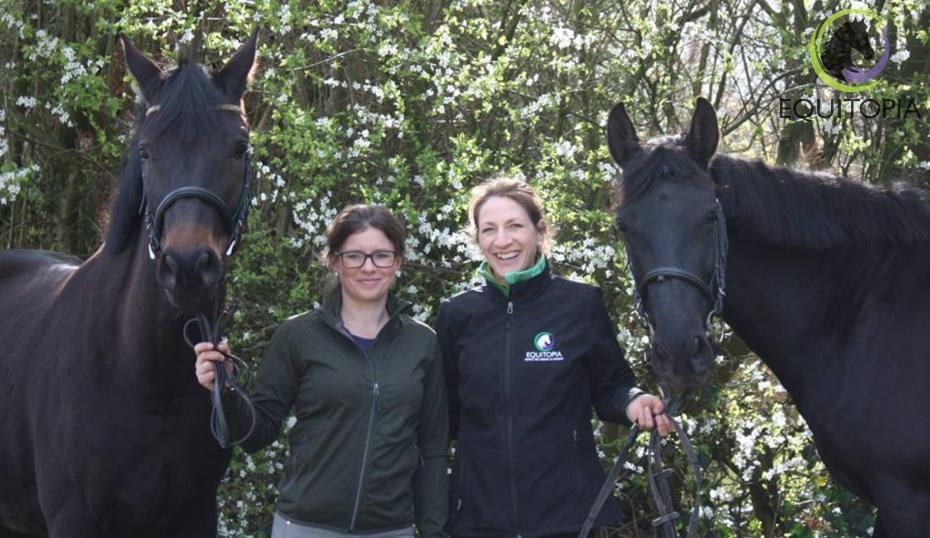BY LOTTA KATRINA HEINZ AND SUSANNE ALLOUSH
DEVELOPING THE ‘NATURAL GO’ IN THE YOUNG RIDING HORSE REQUIRES PATIENCE
In the first weeks of training, there is a lot the horse needs to get used to before we ask him for any actual work. He has to get used to carrying a saddle, wearing a bridle, walking calmly next to a human and working correctly on the lunge. Only after he has mastered all of this can he be asked to carry the weight of the rider.
In this initial phase the horse can progress fairly quickly or he will need a lot of time. It’s up to the horse, he will decide when it’s time to go on. Only when the horse is ready for it can you continue with the next step. It is very important to always work with a young horse in a stress free environment and in a relaxed mind set. After the horse has gotten used to the rider, our goal is to develop his natural desire to go forward.
RESPECT YOUR HORSE’S NATURE AND BEHAVIOUR
One of the first lessons to teach a young horse is for him to go forward without pulling on his mouth – never influence the horse’s mouth with your hands! The classical training of a horse works with the horse’s natural instincts, not against them. This is essential in developing a “natural go”. A very good instrument to develop the forward movement is riding in a group. When riding in a “Rudel” (in a herd), the lazy horses will walk more diligently and nervous or fast horses will calm down. All in a natural way, respecting the horse’s nature and behaviour.
Observe the horses in the video below. The one in the middle is a young horse, who is just learning how to accept the rider. In front there is an older, more experienced horse keeping a steady tempo. This way the young horse will learn to go freely forward. The horse in the back is a lively horse and his rider is insecure. She is learning how to trust her horse to go forward and relax in the saddle. When she achieves that she will be able to convey her relaxation to her horse and that will make riding easier for both of them.
The video below shows the continued education of a young mare, Finest Filipa, a four year old Westfale (Finest x Grosso Z). The rider is concentrating on developing the horse’s natural go, without restraining her with the reins. When the mare finds her balance, her neck will naturally find the forward, down and out posture.
In the first phase of riding a young horse, it is your responsibility to make him sensitive to your leg aids by allowing him to go forward with joy. You must never pull on the reins and never make his head go down with your hand – that will destroy the horse’s desire to move forward and cause long term damage. The horse needs to fall in love with your hands!
ABOUT THE AUTHORS OF THIS POST
Lotta Katrina Hinz is a professional classic dressage instructor, based in the north of Germany (Schleswig-Holstein). She runs her own stable, which offers education and boarding. Lotta is specialized in the classical and correct basic training of young horses. Her theory is based on the principles of the “Army service regulations of 1912”, (Heeresdienstvorschriften 1912), the “Gymnasium of the horse 1884” and the “principles of riding” (“Richtlinien der Deutschen Reiterlichen Vereinigung”). Lotta gives lessons and teaches all throughout the north of Germany. She emphasises the importance of following classical principles, as they build on each other in a systematic way. The priority is always the natural suppleness of the horse. She also helps young horses that are not in balance yet and corrects horses that have been trained in an incorrect way.
It is Lotta’s passion to help riders and horses! It’s important to her to ride and feel but also to dig deep into the theory to learn and to understand. She sees riding and understanding the biomechanics of riding as an art one develops throughout their lifetime – you should always be critical to yourself and never stop asking or learning! Lotta’s mentor and trainer is Dr. Gerd Heuschmann who is a world renowned advocate for the wellbeing of the horse.
Susanne Alloush is a non-professional rider, but a professional social worker/ pedagogue and riding pedagogue. She works as much as possible with Lotta Hinz and supports her. She organizes clinics and helps wherever someone needs a hand. She also translates for Lotta.Susanne has always been with horses and has a natural instinct for the needs of the horse. Her greatest passion is teaching children and teenagers about horses. Susanne helps children who cannot afford or have no possibility to be with a horse. To see a child’s smile while it’s sitting on the horseback for the first time, is the greatest gift to her.
IF YOU FOUND THIS POST INTERESTING, YOU MIGHT BE INTERESTED TO SEE MORE ON THIS TOPIC:
https://www.equitopiacenter.com/courses/chiropractic-care-2/
For more resources, check out the Equitopia membership program – click here



